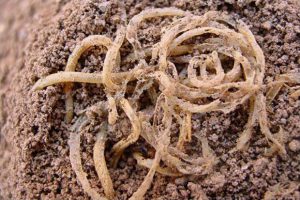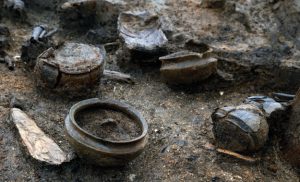Archeology and identity are connected and intertwined due to identity’s reliance on symbolism. As humans became more sedentary the development of long-term communities was immediately coupled with the creation of important physical spaces.
Throughout history we’ve seen the destruction of monuments and important archeological sites as an effective form of psychological warfare. However, the reality of a Westernized bias means that many of us think of “others” as completing these acts of destruction: terrorist groups, uneducated and corrupt governments, and desperate civilians. This is also usually associated with poorer countries with less infrastructure (which is relative, because what even is a normal/correct infrastructure?). In class we’ve looked at the Babri Mosque, ISIS, looting in Syria, Iraq, and Peru, but what about our country?
When the United States invaded Iraq in 2003, they destroyed numerous archeological and cultural sites. Many areas were converted into military bases, including the ancient city of Babylon (Jenkins 2007). Troops vandalized and pillaged cultural sites in order to convert them into military spaces. Though it appears that the government attempted to avoid archeological destruction, with the inclusion of archeologists in strategic military planning, the reality is that war as a practice is inherently destructive (Hamilakis 2009). For example, the City of Ur was surrounded by military basis, and thus pillaged and vandalized (Vulliamy 2003). Avoidance of cultural destruction therefore has to be synonymous with the avoidance of conflict.
There is also an inherent bias, not only in the acts of destruction, but in the denouncement and publicization of it. Though Western countries tend to portray themselves as the model for intellectual preservation and understanding we can look to history to see how we favor and exploit the practice of archeology. During World War II “American officers persuaded allied commanders to avoid combat inside Florence, birthplace of the Italian Renaissance” (Tucker). Here we see a very eurocentric understanding of conflict avoidance and preservation, whereas in Iraq the destruction of identity under the destruction of archeological sites was abetted by a lack of preservative action.
I believe archeology is inherently political, even with the theory of identity fluidity. Though emphasizing the changeability of groups can be used to suppress conflicts, like in the case of the Babri Mosque, it can also be used to justify modern day destruction. This retrospective understanding of “history changes identities” means that one could justify Iraq’s destruction by stating how the U.S. invasion is a development in history, and thus just as important as the sites it’s destroying. I think that in order for archeology to be a decolonized, anti-imperialist tool it can’t be used for divisive political purposes, and instead must be a factually based, all-inclusive, non-for-profit, pacifist-like practice. Even though archeology proves the long-rooted history and inevitability of warfare, that doesn’t mean that it can’t take a stance against it.
Additional Reading
UNESCO. Final Report on Damage Assessment in Babylon. 2009. http://unesdoc.unesco.org/images/0018/001831/183134E.pdf
“Ancient city of Babylon destroyed by US base.” Al Arabiya News, 23 May 2008, https://www.alarabiya.net/articles/2008/05/23/50297.html.
Image Sources
India, Sabrang. “Conspiracy Behind the Demolition of the Babri Masjid: Salient Points of the SC Decision.” Newsclick, 20 Apr. 2017, https://newsclick.in/conspiracy-behind-demolition-babri-masjid-salient-points-sc-decision.
“Destroying Cultural Sites: Something ISIL and US Army Have in Common.” Sputnik, 3 Nov. 2015, https://sputniknews.com/middleeast/201503111019334234/.
Sources
Hamilakis, Yannis. “The “War on Terror” and the Military–Archaeology Complex: Iraq, Ethics, and Neo-Colonialism.” Archeologies, vol. 5, no. 1, 2009, pp. 39-65.
Jenkins, Simon. “In Iraq’s four-year looting frenzy, the allies have become the vandals.” The Guardian, 7 June 2007, https://www.theguardian.com/commentisfree/2007/jun/08/comment.iraq.
Tucker, Diane. “Brutal Destruction Of Iraq’s Archaeological Sites Continues (SLIDESHOW).” Huffpost, https://www.huffingtonpost.com/diane-tucker/brutal-destruction-of-ira_b_290667.html.
Vulliamy, Ed. “Troops Vandalise Ancient City of Ur.” The Observer, 17 May 2003, https://www.globalpolicy.org/component/content/article/167/35497.html.
Bernbeck, Reinhard, and Susan Pollock. “Ayodhya, Archaeology, and Identity.” Current Anthropology, vol. 37, no. 1, 1996, pp. S138–S142. JSTOR, JSTOR, www.jstor.org/stable/2744239.




